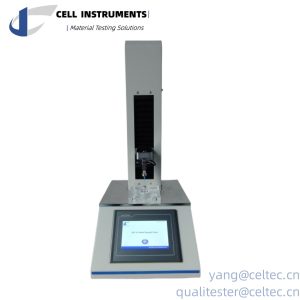ゴム栓の貫通性試験
ゴム栓の浸透性試験の重要性
浸透性試験は、注射器に使用されるような医療用針がバイアルのゴム栓を貫通するのに必要な力を評価します。
品質管理
この試験は、ゴム栓が薬剤容器を効果的に密封し、汚染や漏れ、患者への危害の可能性を防ぐために極めて重要です。ゴム栓の浸透性を正確に測定することで、メーカーは製品の完全性と患者の安全性の最高基準を維持することができ、最終的に医薬品の信頼性と有効性に貢献します。
医療用針の開発
研究開発実験室では、貫通性試験により、さまざまな設計の針の性能と耐久性についての重要な洞察が得られます。さまざまな組成や厚さのゴム栓を貫通するのに必要な力を測定することで、メーカーは、ゲージ、先端形状、表面仕上げなどの針設計パラメーターを最適化することができる。これらの最適化は、刺通性の向上、針の破損や変形のリスクの最小化、医療従事者や患者の全体的な使用感の改善を目的としています。
バイアルゴム栓の開発
同様に、浸透性試験はゴム栓技術の進歩において極めて重要な役割を果たしています。体系的な試験を通じて、メーカーは材料の配合、加工技術、構造上の特徴がストッパーの浸透性に与える影響を評価することができます。このデータは、シールの完全性と針の刺しやすさの最適なバランスを実現するゴム栓の開発に役立ちます。浸透性試験結果に基づいてストッパーの設計を繰り返し改良することで、メーカーは幅広い医療機器や製剤との適合性を確保しながら、厳しい性能要件を満たす製品を提供することができます。
プロセス - ゴム栓の浸透性試験
貫通性試験では、ゴム栓を固定し、一定の速度で針で穴を開ける。ストッパーを貫通するのに必要な力が測定され、確立された基準と比較される。
- ゴム栓は試験装置にしっかりとセットされる。
- 注射器に使用されるような標準的な医療用針をストッパーに合わせる。
- 制御された力が徐々に針に加えられ、ストッパーに穴を開けるプロセスをシミュレートする。
- 針がストッパーを貫通するのに必要な力が測定され、記録される。
このプロセスでは、耐パンク性、セルフシール能力、ストレス下での総合的な性能などの要素を評価する。
ゴム栓の浸透性試験 関連規格
医薬品用ゴム栓の浸透性試験にはいくつかの規格があり、業界全体の一貫性と信頼性を保証しています。一般的に参照される規格には、ISO 7886やUSP があります。これらの規格は、ストッパーの貫通性を評価するための試験方法、装置要件、および合格基準を概説しています。
ゴム栓溶液の浸透性試験-医療用針刺し試験機
セルインストゥルメンツ を提供している。 NPT-01 医療針穿刺テスターこの自動試験機は、医薬品用ゴム栓の浸透性試験専用に設計された最先端の装置です。この自動試験機は、試験パラメーターを正確に制御し、正確で再現性の高い結果を保証します。ユーザーフレンドリーなインターフェースとカスタマイズ可能な機能により、NPT-01は高い精度と信頼性を維持しながら試験プロセスを合理化します。
よくある質問
1.ゴム栓の浸透性に影響を与える主な要因は何ですか?
ストッパーの材質、厚さ、検査に使用する針の設計は、浸透性に影響を与える重要な要因である。
2.浸透性試験は医薬品の安全性にどのように貢献するか?
浸透性試験は、ゴム栓が薬剤容器を効果的に密封し、汚染や漏れを防ぎ、患者の健康に悪影響を及ぼす可能性がないことを確認するのに役立ちます。
3.浸透性試験は、特定の業界要件に合わせてカスタマイズできますか?
NPT-01医療用針刺し試験機は、さまざまな試験ニーズに対応するカスタマイズ機能を備えており、製薬業界における幅広い用途に適しています。
4.浸透性試験で注意すべき点は?
サンプルのゴム栓は製造バッチから選択され、代表的なサンプルが試験用に選択される。これらのストッパーは、ばらつきを考慮し、製造の異なる段階から供給されることもあります。
5.NPT-01医療用針刺し試験機は、従来の試験方法とどのように違うのですか?
NPT-01は、高度な自動化、精密制御、ユーザーフレンドリーな操作性を提供し、従来の手動式検査方法と比較して、効率と精度を大幅に改善します。


